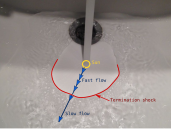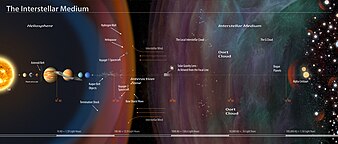
Back Heliosfeer Afrikaans Heliosfera AN غلاف شمسي Arabic هيليوسفير ARY Heliosphean BAR Геліясфера Byelorussian Хелиосфера Bulgarian সৌরমণ্ডল Bengali/Bangla Heliosfera Catalan خۆرەگۆ CKB
- Top: Diagram of the heliosphere as it travels through the interstellar medium:
- Heliosheath: the outer region of the heliosphere; the solar wind is compressed and turbulent
- Heliopause: the boundary between the solar wind and interstellar wind where they are in equilibrium.
- Middle: water running into a sink as an analogy for the heliosphere and its different zones (left) and Voyager spacecraft measuring a drop of the solar wind's high-energy particles at the termination shock (right)
- Bottom: Logarithmic scale of the Solar System and Voyager 1's position..
The heliosphere is the magnetosphere, astrosphere, and outermost atmospheric layer of the Sun. It takes the shape of a vast, tailed bubble-like region of space. In plasma physics terms, it is the cavity formed by the Sun in the surrounding interstellar medium. The "bubble" of the heliosphere is continuously "inflated" by plasma originating from the Sun, known as the solar wind. Outside the heliosphere, this solar plasma gives way to the interstellar plasma permeating the Milky Way. As part of the interplanetary magnetic field, the heliosphere shields the Solar System from significant amounts of cosmic ionizing radiation; uncharged gamma rays are, however, not affected.[1] Its name was likely coined by Alexander J. Dessler, who is credited with the first use of the word in the scientific literature in 1967.[2] The scientific study of the heliosphere is heliophysics, which includes space weather and space climate.
Flowing unimpeded through the Solar System for billions of kilometers, the solar wind extends far beyond even the region of Pluto, until it encounters the "termination shock", where its motion slows abruptly due to the outside pressure of the interstellar medium. The "heliosheath" is a broad transitional region between the termination shock and the heliosphere's outmost edge, the "heliopause". The overall shape of the heliosphere resembles that of a comet; being roughly spherical on one side, with a long trailing tail opposite, known as "heliotail".
Two Voyager program spacecraft explored the outer reaches of the heliosphere, passing through the termination shock and the heliosheath. Voyager 1 encountered the heliopause on 25 August 2012, when the spacecraft measured a forty-fold sudden increase in plasma density.[3] Voyager 2 traversed the heliopause on 5 November 2018.[4] Because the heliopause marks the boundary between matter originating from the Sun and matter originating from the rest of the galaxy, spacecraft that depart the heliosphere (such as the two Voyagers) are in interstellar space.
- ^ Gale Martha (1 April 2013). "The Sun's Heliosphere".
- ^ Cite error: The named reference
dessler-revgeophyswas invoked but never defined (see the help page). - ^ Cite error: The named reference
voyager-historicwas invoked but never defined (see the help page). - ^ Cite error: The named reference
v2-heliopausewas invoked but never defined (see the help page).



